Horn Book Fanfare 2017
A couple of weeks ago our advertising director Al Berman emailed me with a noodge: “have you guys finished FanFare yet?” Yes, we have, Al, and here it is, and also yes, your creative miscapitalization of Fanfare will live in my steel-trap Scorpio mind forever.

A couple of weeks ago our advertising director Al Berman emailed me with a noodge: “have you guys finished FanFare yet?” Yes, we have, Al, and here it is, and also yes, your creative miscapitalization of Fanfare will live in my steel-trap Scorpio mind forever. But we do hope this list of the Horn Book’s favorite books of 2017 will provide reading fare for reading fans of all ages.

Roger Sutton
Editor in Chief
Picture Books
 Crown: An Ode to the Fresh Cut
Crown: An Ode to the Fresh Cutwritten by Derrick Barnes, illustrated by Gordon C. James; Millner/Bolden Books/Agate
(Primary)
A boy’s weekly trip to the barbershop boosts his self-esteem and therefore his place in the universe. Color-saturated illustrations capture the protagonist’s bravado, swagger, and even humility (in accepting a post-cut kiss from his admiring mother); the descriptions in the text are alternately precise, metaphorical, and culturally specific. A not-to-be-missed portrayal of the beauty of black boyhood. Review 11/17.
 The Wolf, the Duck, and the Mouse
The Wolf, the Duck, and the Mouse written by Mac Barnett, illustrated by Jon Klassen; Candlewick
(Primary)
Barnett and Klassen’s latest collaboration is a delightfully entertaining mash-up of familiar storytelling tropes, combined in a wholly original way. A hungry wolf. An unlikely friendship. Hilarious surprises with every page-turn lead to a pourquoi-tale ending you won’t see coming. The child-friendly humor in Klassen’s illustrations almost belies their depth and sophistication. Review 11/17.
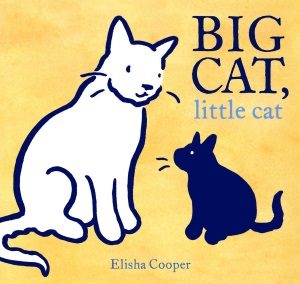 Big Cat, Little Cat
Big Cat, Little Catwritten and illustrated by Elisha Cooper; Roaring Brook
(Preschool, Primary)
“There was a cat // who lived alone. / Until the day // a new cat came. // …Big cat, little cat.” This spare, poignant story follows the passage of years and the first cat’s death, then the now-grown second cat’s own new kitten friend. Minimalist illustrations — in thick black lines framed by plenty of white space — are imbued with quintessentially feline personality. Review 3/17.
 Wolf in the Snow
Wolf in the Snowwritten and illustrated by Matthew Cordell; Feiwel
(Primary)
A child bundled in a red-hooded parka braves a blizzard to return a lost wolf pup to its pack. Dynamic pen-and-ink and watercolor illustrations in a limited palette strike a masterful balance of realistic detail and emotion; together with the sound-effects-only text, they keep suspense high until both youngsters are safely reunited with their families. Review 11/16.
 The Rooster Who Would Not Be Quiet!
The Rooster Who Would Not Be Quiet!written by Carmen Agra Deedy, illustrated by Eugene Yelchin; Scholastic
(Preschool, Primary)
In a village where noise has been outlawed, one gallito can’t keep from singing, even under increasingly dire threats. This inspiring and often funny original story’s cadences echo classic folktales, with lively art whose dull hues when Don Pepe comes into power contrast with the bright colors and energy at moments of resistance. Kee-kee-ree-KEE! Review 5/17.
 Windows
Windowswritten by Julia Denos, illustrated by E. B. Goodale; Candlewick
(Preschool, Primary)
A brown-skinned child (the “you” of the text) puts on a red hoodie and takes the family dog for an evening walk, musing on the activities glimpsed through windows along the way. This book stands out for its matter-of-fact portrayal of a diverse neighborhood, its lyrical language, and its stunningly atmospheric art, with a spectacular sunset providing a luminous glow. Review 11/17.
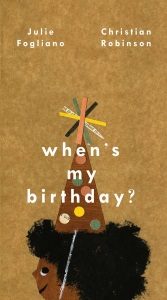 When’s My Birthday?
When’s My Birthday?written by Julie Fogliano, illustrated by Christian Robinson; Porter/Roaring Brook
(Preschool)
A stream-of-consciousness text playfully and rhythmically captures a child’s obsession with that all-important day: “when’s my birthday? / where’s my birthday? / how many days until / my birthday?” Robinson’s joyful, anticipation-building cut-paper and paint illustrations add texture and dimension; with the tall, narrow trim size, the whole festive package feels like a birthday card. Review 9/17.
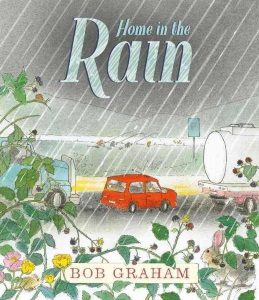 Home in the Rain
Home in the Rainwritten and illustrated by Bob Graham; Candlewick
(Primary)
While driving home in the bucketing rain, Francie’s pregnant mom is forced off the highway. She pulls over (safely), and mother and daughter share a snack and conversation. What will the baby’s name be? When will Daddy, “working far out to sea,” be home? Graham merges Francie’s story with those of others (human and animal) glimpsed along the highway; the result is both down-to-earth and transcendent. Review 9/17.
 Egg
Eggwritten and illustrated by Kevin Henkes; Greenwillow
(Preschool)
Four pastel-hued eggs occupy separate quadrants of the page: “egg / egg / egg / egg.” Three of the eggs hatch: “crack / crack / crack / egg.” The chicks, increasingly impatient, launch a furious pecking campaign, but what emerges from the fourth egg is not another chick. “Surprise!” What to do? Spot-on pacing and preschooler-perfect humor propel Henkes’s innovative picture book. Review 1/17.
 The Little Red Cat Who Ran Away and Learned His ABC’s (the Hard Way)
The Little Red Cat Who Ran Away and Learned His ABC’s (the Hard Way)written and illustrated by Patrick McDonnell; Little, Brown
(Preschool, Primary)
That long, rangy title is just right for this compulsively forward-moving tale of a cat who races out the door and into adventure. The alphabet provides the story’s structure; the heart and energy come from McDonnell’s cartoons, expertly paced and minimally lined for maximum effect. Review 7/17.
 A Different Pond
A Different Pondwritten by Bao Phi, illustrated by Thi Bui; Capstone
(Primary, Intermediate)
Hours before sunrise, a father and son go fishing for that night’s meal. So begins this powerfully understated picture book about a Vietnamese refugee family living in the U.S. in 1982. With culturally rich detail, the text describes the family’s joys and struggles. Expressive brushwork, lush hues, and varied page design set a contemplative mood. Review 9/17.
 When We Were Alone
When We Were Alonewritten by David Alexander Robertson, illustrated by Julie Flett; HighWater Press
(Primary)
“Nókom, why do you wear so many colours?” A contemporary First Nations girl poses a series of questions to her grandmother. Using descriptive language and effective repetition, Nókom relates the oppression she and other Indigenous children endured in a residential school. Evocative earth-toned collage illustrations contrast the school’s bleakness with the beauty of the students’ quiet resistance in stolen moments. Review 3/17.
 After the Fall: How Humpty Dumpty Got Back Up Again
After the Fall: How Humpty Dumpty Got Back Up Againwritten and illustrated by Dan Santat; Roaring Brook
(Preschool, Primary)
What if all the king’s men did manage to put Humpty Dumpty back together? Alas, his problems are just beginning. Santat takes the fractured (heh) fairy-tale genre to new heights in a story that moves from a jokey beginning to an emotionally resonant conflict. A sequence of three powerfully composed double-page spreads provides a stunning, uplifting (heh heh) conclusion. Review 11/17.
 Town Is by the Sea
Town Is by the Seawritten by Joanne Schwartz, illustrated by Sydney Smith; Groundwood
(Primary)
A boy describes an ordinary summer’s day in his 1950s seaside coal-mining town. He contemplates the majestic sea — and his father’s dangerous work “under the sea, deep down in the coal mines.” Gorgeous illustrations, alternately arresting and poignant, augment the lyrical, candid narration, with its undertones of anxious waiting and foreboding. Review 3/17.
Fiction
 The War I Finally Won
The War I Finally Wonwritten by Kimberly Brubaker Bradley; Dial
(Intermediate)
This sequel to The War That Saved My Life (rev. 1/15) contains a wealth of WWII British home-front incident; throughout it all runs the thread of feisty Ada’s emotional healing from abuse as she slowly grows into the young woman she wants to be. Bradley raises hard questions and makes us think — even as she moves us to tears. Review 9/17.
 It All Comes Down to This
It All Comes Down to Thiswritten by Karen English; Clarion
(Intermediate, Middle School)
Living in a wealthy neighborhood doesn’t protect Sophie, who is African American, from difficult racial realities in 1965 Los Angeles. Sophie’s reactions to these challenges — which come to a crescendo with the unrest in Watts — result in a true coming-of-age story from an underrepresented and welcome perspective. Interactions with her white best friend allow for a particularly honest dialogue. Review 7/17.
 The Fashion Committee: A Novel of Art, Crime, and Applied Design
The Fashion Committee: A Novel of Art, Crime, and Applied Designwritten by Susan Juby; Viking
(High School)
A chipper fashionista and a chip-on-his-shoulder metalworker face off in a fashion competition to win a scholarship to a ritzy arts high school (first introduced in The Truth Commission, rev. 3/15). This whip-smart comedy is by turns hilarious and heartrending, but always entertaining, with poignant observations on socioeconomic status and diversity of all stripes. Review 7/17.
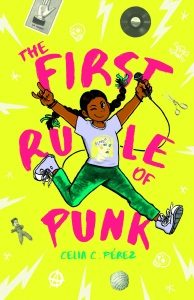 The First Rule of Punk
The First Rule of Punkwritten and illustrated by Celia C. Pérez; Viking
(Intermediate, Middle School)
Middle-grade fiction gets a robust hero in Malú, daughter of a Mexican American mother and Anglo father (divorced but friendly). Moving to Chicago from Gainesville, Florida, for Mom’s new job is wrenching at first; but Malú’s new Mexican American neighborhood puts her in touch with her heritage, and Dad’s lessons in cheerful anarchy — and zine-making — give her sustenance. Review 7/17.
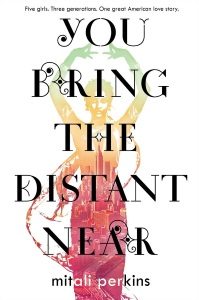 You Bring the Distant Near
You Bring the Distant Nearwritten by Mitali Perkins; Farrar
(Middle School, High School)
Beginning in 1973, three generations of women in the Das family relate their interwoven stories of love, friendship, cultural identity, and self-actualization. If ever the intricate complexities of immigrant families living between homelands were in doubt, Perkins has laid them unquestionably to rest in this sprawling, emotion-filled multigenerational novel about strong and complicated East Indian girls and women. Review 9/17.
 Long Way Down
Long Way Downwritten by Jason Reynolds; Dlouhy/Atheneum
(High School)
Will steps into an elevator, planning to take revenge on his brother’s killer. But on each descending floor he is joined by the ghost of a victim or perpetrator of the violence that plagues his neighborhood. Reynolds’s verse novel is stark, immediate, and dramatic; the last page-turn reveals the best closing line of a novel this year. Review 7/17.
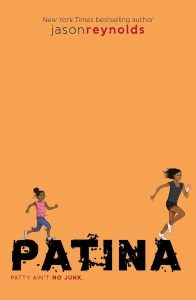 Patina [Track]
Patina [Track]written by Jason Reynolds; Dlouhy/Atheneum
(Intermediate, Middle School)
This second series entry highlights Defenders track team member Patina. Patty holds herself to impossibly high standards, whether it’s winning every race or taking full responsibility for her little sister’s care; an almost-tragedy in her family finally allows her to let go, and to grieve for her late father. A layered, authentic, affecting portrayal of an African American middle schooler facing adversity and loss. Review 11/17.
 The Hate U Give
The Hate U Givewritten by Angie Thomas; Balzer + Bray/HarperCollins
(High School)
Sixteen-year-old Starr lives a life of double consciousness, caught between her predominantly black neighborhood and her mainly white prep school. This precarious balance is inexorably tipped after she witnesses the police shooting of her (unarmed) childhood friend. Starr’s razor-sharp narrative voice is unforgettable — as are her vulnerability and the gut-wrenching choices she faces. Review 3/17.
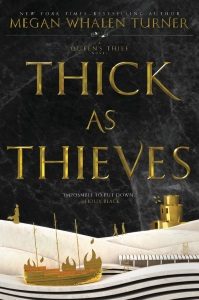 Thick as Thieves [Queen’s Thief]
Thick as Thieves [Queen’s Thief]written by Megan Whalen Turner; Greenwillow
(Middle School, High School)
The slave Kamet, on the run for his life, reluctantly agrees to an enemy soldier’s offer to escort him to freedom. Their journey to Attolia is dangerous and eventful; by the end, it has shaken all of Kamet’s certainties and assumptions. Turner’s fifth Queen’s Thief novel (beginning with The Thief, rev. 11/96) showcases her many fortes: ingenious plotting, nuanced characterization, and a subtle sleight of hand in the telling. Review 5/17.
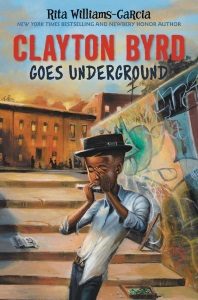 Clayton Byrd Goes Underground
Clayton Byrd Goes Undergroundwritten by Rita Williams-Garcia, illustrated by Frank Morrison; Amistad/HarperCollins
(Intermediate, Middle School)
The sudden death of his beloved grandfather, a blues musician, devastates Clayton. When his mother ruthlessly tries to excise the memory of the man from their lives, Clayton takes to the underworld, an Orpheus armed with a blues harp in the New York subway. Clayton’s journey, both physical and emotional, is related with immediacy; his love of his grandfather — and of music — provides a strong thematic through-line. Review 5/17.
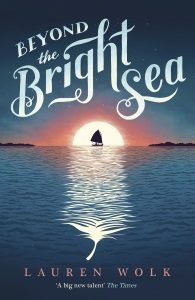 Beyond the Bright Sea
Beyond the Bright Seawritten by Lauren Wolk; Dutton
(Intermediate, Middle School)
Wolk’s moody, atmospheric mystery takes place in 1925 on the Elizabeth Islands off Cape Cod, where Crow washed up as a newborn twelve years earlier. When her curiosity is piqued by strange doings on a nearby uninhabited island, she begins to uncover clues about her origins. Buried treasure, deadly storms, and murderous pursuit combine with an exceptionally nuanced exploration of self and family. Review 7/17.
Nonfiction
 Eyes of the World: Robert Capa, Gerda Taro, and the Invention of Modern Photojournalism
Eyes of the World: Robert Capa, Gerda Taro, and the Invention of Modern Photojournalism written by Marc Aronson and Marina Budhos; Holt
(High School)
This riveting biography of photographers Robert Capa and Gerda Taro immerses readers in the horrific details of the Spanish Civil War and 1930s international discord while illustrating the development of photojournalism as an art form with political import. A sharp page design showcases the many photos, and a multilayered narrative invites striking parallels to today’s world. Review 5/17.
 Rivers of Sunlight: How the Sun Moves Water Around the Earth [Sunlight]
Rivers of Sunlight: How the Sun Moves Water Around the Earth [Sunlight]written by Molly Bang and Penny Chisholm, illustrated by Molly Bang; Blue Sky/Scholastic
(Primary)
Richly colored paintings illuminate this detailed description of how the sun’s energy affects our water cycle, from the drinking water that regulates our bodies to the massive systems underground and in the atmosphere. The text provides solid science in a clear, holistic way while the illustrations’ depictions of waves, particles, and currents are masterfully composed. Review 3/17.
 Grand Canyon
Grand Canyonwritten and illustrated by Jason Chin; Porter/Roaring Brook
(Primary, Intermediate)
A father and daughter hike from the bottom of the Grand Canyon to the rim where — in a dazzling, immersive gatefold illustration — they marvel at “the grandest canyon on Earth.” Travel guide–like narration packed with detailed scientific information accompanies scenic watercolors whose strategic die-cuts transport readers through geological history. Review 1/17.
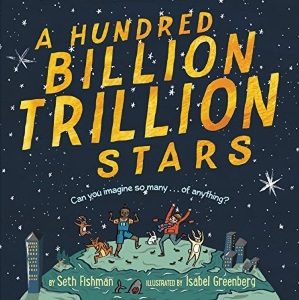 A Hundred Billion Trillion Stars
A Hundred Billion Trillion Starswritten by Seth Fishman, illustrated by Isabel Greenberg; Greenwillow
(Primary)
Setting the numeral 100,000,000,000,000,000,000,000 across a double-page spread of stars is an impressive beginning for this mind-expanding survey of the really big numbers that compose our world and universe. Trippiest concept? “By the time you’re done reading this book, almost every single number in it will have changed.” The illustrations are both capacious and cozy. Review 1/18.
 Vincent and Theo: The Van Gogh Brothers
Vincent and Theo: The Van Gogh Brotherswritten by Deborah Heiligman; Holt
(High School)
Drawing on copious correspondence and archival documents, Heiligman deftly traces the tumultuous trajectories of the Van Gogh brothers’ turbulent lives in a present-tense, immediate narrative. An unflinching examination of Vincent’s and Theo’s personal triumphs and tragedies, this dual biography celebrates the fraternal bond and love of art that connected them. Review 3/17.
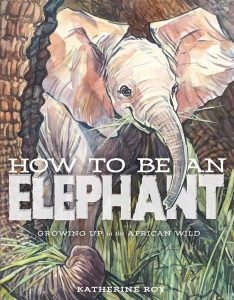 How to Be an Elephant: Growing Up in the African Wild
How to Be an Elephant: Growing Up in the African Wildwritten and illustrated by Katherine Roy; Macaulay/Roaring Brook
(Primary, Intermediate)
A young African elephant learns how to survive in the wild, surrounded by the (huge) elder members of its herd. The detailed text explains elephant anatomy, behavior, and development, while dynamic paintings skillfully convey movement. Fascinating diagrams and cutaways provide sometimes-humorous details of long-distance communication, “smell-o-vision,” and the multipurpose trunk. Review 9/17.
 Undefeated: Jim Thorpe and the Carlisle Indian School Football Team
Undefeated: Jim Thorpe and the Carlisle Indian School Football Teamwritten by Steve Sheinkin; Roaring Brook
(Middle School, High School)
This remarkable book is: a compelling biography of Native American football icon Thorpe (who was Sac and Fox); a well-contextualized history of the infamous Carlisle Indian Industrial School; an examination of the complicated bonds between a legendary coach, Glenn “Pop” Warner, and his players; a thrilling play-by-play sports narrative; and an unlikely but undeniable page-turner for people who don’t care a bit about football. Review 3/17.
From the January/February 2018 issue of The Horn Book Magazine. For previous years’ Fanfare lists, click on the tag Fanfare list.
RELATED
RECOMMENDED
ALREADY A SUBSCRIBER? LOG IN
We are currently offering this content for free. Sign up now to activate your personal profile, where you can save articles for future viewing.







Add Comment :-
Be the first reader to comment.
Comment Policy: